Fact file:
Matriculated: 1906
Born: 14 June 1887
Died: 29 September 1916
Regiment: Royal Army Medical Corps
Grave/Memorial: Puchevillers British Cemetery: III.B.11
Family background
b. 14 June 1887 at Pinxton, Derbyshire, near Mansfield, Nottinghamshire. He was the eldest son of Dr Maurice Parry-Jones, MD (1857–1940) and Mrs Helen Anna Maria Parry-Jones (1855–1937) (née Burt) (m. 1886). At the time of the 1891 Census the family was living at High Street, Alfreton, Derbyshire (three servants), in 1901 at 4 Full Street, Derby (four servants) and in 1911 at the same address (three servants).
Parents and antecedents
Parry-Jones’s father, born in Sarn, Montgomeryshire, was the son of John Parry Jones (1819–88) from Radnorshire, who at the time of the 1871 Census was a commercial traveller in silk, linen and cotton goods. His family lived at the Vineyard, Hereford, with a governess and two servants. When Maurice was 16 he became a junior master at a preparatory school in order to raise the money for a medical education. When he was 21 he entered Guy’s Hospital (1878–85), where he was awarded his MB and MRCS in 1883 and MD in 1885. When the Hereford Times reported his examination successes in 1878 his home address was given as Overbury Lodge, Hereford, where his father was living at the time. Maurice worked as a house-surgeon and resident obstetric house-surgeon at Guy’s and prosector at the Royal College of Surgeons before being appointed resident medical officer to the City of London Hospital for Diseases of the Chest, where he became particularly interested in diseases of the heart and lungs. In 1886 he accepted a colliery appointment at Pinxton, in Derbyshire, but this did not satisfy his clinical ambitions, and in 1898 he moved to the County Hospital, Derby. The Pinxton post was not particularly well-paid either, for in 1891 his family included three boarders and three servants. Dr Maurice Parry-Jones was subsequently appointed assistant physician and then consulting physician to the Derbyshire Royal Infirmary. He belonged to the older school of medical practitioner and attached much importance to physical symptoms. An obituarist said that:
he was at his best during a ward round, when it was a pleasure to watch him examine a difficult case before arriving at a careful diagnosis that was based on his extensive knowledge of morbid anatomy, gained by routine visits to the post-mortem room.
Whether the prognosis was then good or bad, he would take particular care when explaining it to the patient or his/her friends, and revealed in so doing his great sympathy for and understanding of his fellow creatures. The obituarist continued: “He always gave careful attention to the details of treatment, especially diet and drugs, of which he also had an extensive knowledge.” Given his clinical skill and fund of common sense, his practice grew and his advice was sought by patients and colleagues from all over the county of Derbyshire. He was a keen supporter of the Derby Medical Society, rarely missing a meeting, and was a member of the British Medical Association for 40 years. Although he was extremely happy in his domestic and professional life, the death of his son Owen on the Somme was a grievous blow. Despite developing double glaucoma and cataracts, he continued in practice until 1927, when he retired to live at 5 Wellswood Park, Torquay. Next to clinical medicine and the welfare of his hospital, his interest was music: he had a good bass voice, and took a prominent part in musical activities in Derby and Torquay.
Owen Guy’s mother was one of the 14 children of the Reverend John Thomas Burt (c.1811–1892), who was the Chaplain to, successively, Hanwell Asylum (1841–44), the Birmingham Borough Gaol (1855–63) and the newly established Broadmoor Government Asylum (1863–80), and then became Rector of Widdington, Essex (1880–92). During his ministry, Mr Burt established a reputation of being someone with a special gift of communicating with the mentally ill. Helen Anna herself was a nurse and known as Sister Cornelius.
Siblings and their families
Brother of:
(1) John (b. 1890, d. in infancy);
(2) Percival Edward Holland (1892–1942); married (1928) Jane Elizabeth Slade Carey (1901–90); three daughters, one son;
(3) Margaret Joyce (1894–1983); later Smith after becoming the second wife (in 1927) of Gerard Hamilton Smith (c.1876–1962), who had one son from his marriage (1903) to Lucy Elizabeth Onslow (1900–25); Margaret Joyce and Gerard then had one daughter.

Percival Edward Holland Parry-Jones
(Courtesy of Sherborne School)
Percival Edward Holland was born in Alfreton, Derbyshire, and, like his elder brother, he attended Sherborne School (1905–11) where, according to his obituarist, he became a “prominent member of the Sixth Form [School Prefect], Captain of the School XV in his third year in the side, and a Silver Medallist and School representative in the Public Schools Boxing [tournament]”. He matriculated at Pembroke College, Cambridge, in October 1911 and began by reading History there, with a view to becoming a schoolmaster. In summer 1913 he took Part I of the Historical Tripos, in which he was not classed, but he was allowed to read for the ordinary BA degree and excused the special examination in History. In Easter Term 1914 he was awarded a 3rd in the special examination in Geography and graduated with a BA (Ordinary Degree) on 20 June 1914.
On the outbreak of war he was commissioned Second Lieutenant in the 5th (Pioneer) Battalion, the South Wales Borderers. On 11 February 1915, while his Battalion was billeted at Burnham, Somerset, Percival Edward saved a bridge-builder from drowning in the river at nearby Newbridge, after a spar had broken and he was thrown into the river. Percival Edward plunged in fully clothed and saved the bridge-builder, an act for which he was awarded the Royal Humane Society’s Bronze Medal. On 24 April he was promoted to temporary Captain (London Gazette, no. 29,141, 24 April 1915, p. 4,038). The battalion disembarked at Le Havre on 16 July 1915.
Percival Edward was wounded in France and then, after the war, returned to his old school as a Tutor in School House (1919–28). He took an MA by proxy on 8 December 1923, and in 1928 he took over as Housemaster of Abbey House at Sherborne from the legendary teacher and sportsman Godfrey Mohun Cecil Carey (1872–1927; Abbey House 1908–27), whose daughter he married in 1928. Like Owen Guy, he had a fine baritone voice and made his House and home “a great centre of music”. He gradually became one of the School’s more charismatic personalities, whom his obituarist described as follows:
The great attractiveness of his personality lay in his remarkable combination of hardness and sensitiveness, of strictness and a real sympathy, of discipline and love. […] He was indeed greatly loved by the overwhelming majority, not indeed by all. The slacker, the shifty, the slovenly, the slipshod, the vulgar and the blatant, these all avoided him – and wisely. Again it was in this wonderful combination of hard discipline and sympathy that lay the secret of his inspiration because he was and is an outstanding example of what real Christianity can be, as opposed to the bogus imitation seen in the simpering saints of our Victorian stained glass windows. It is one of the most difficult things in the world, as every Schoolmaster knows, to rid the minds of boys and men of the common fallacy that Christianity is something soft and sentimental and effeminate, to persuade them that it is hard and virile and heroic; but the task is made comparatively easy when there are men like Edward Parry-Jones about the place.
Concluding the obituary, its author, who became Headmaster of Sherborne from 1934 to 1949, compared Percival Edward to Bunyan’s Mr Valiant-for-Truth, for whom “all the trumpets sounded […] on the other side”. Percival Edward Holland is also credited by Ian Messiter (1920–1999) with giving him the idea for the popular radio parlour game Just a Minute.
Gerard Hamilton Smith was the elder son of a one-time Governor of Western Australia and a member of the family which owned England’s oldest provincial bank, Smith’s of Nottingham (founded in 1658; moved to No. 1, Lombard Street, London, in April 1758). Smith, Ellison & Co., as the firm became in 1792 (also known as the Lincoln Bank), merged with the Union Bank of London in 1902 and the amalgamated bank became the National Provincial & Union Bank Ltd in 1918 and the National Provincial Bank Ltd in 1924. In October 1916 he was appointed temporary Lieutenant in the 8th Battalion of the Derbyshire Volunteer Regiment (London Gazette, no. 29,786, 17 October 1916, p. 9,966). The Derbyshire Volunteer Regiment of Home Guards was established at the beginning of 1915 “to give every able bodied man outside the fighting age (19–36) […] scope for his energies and natural desire to serve his country.” The companies from every Parliamentary Division in the county were organized into Battalions, giving a total of eight Battalions under the command of the Lord Lieutenant, the Duke of Devonshire.
Education and professional life
Parry-Jones attended a preparatory school in Bournemouth, Hampshire, and then, from 1901 to 1906, Sherborne School, where he became a prominent member of the rugby first XV from 1903 to 1906, a School Prefect, the winner of the steeplechase, and a Sergeant in the Officers’ Training Corps. He matriculated at Magdalen as an Academical Clerk on 16 October 1906. Although he had passed some parts of Responsions in September 1906, he re-sat its Classics component during his first term at Oxford, i.e. Michaelmas Term 1906. He sat the First Public Examination in October 1907 and Hilary Term 1908, and then read for a Pass Degree in Natural Sciences (Groups C3 [The Elements of Physics] in Michaelmas, 1908, and B2 [French Language], Trinity Term 1909). He also took one part of the Preliminary Examination in Natural Sciences (Chemistry) in June 1908 and another (Zoology and Botany) in Michaelmas Term 1908. Although he passed Finals in Trinity Term 1909, he did not take his BA until 1 December 1910. During his three years at Magdalen, Parry-Jones captained the College XV and played many times for the University. President Warren, the probable author of his obituary in the Oxford Magazine, tells us that:
he had a fine voice and much taste and it was a distinct loss to the choir when, in order to follow medical studies, he gave up his position there. A manly, able fellow, he had a fair prospect of professional success, now, alas! prematurely cut short.
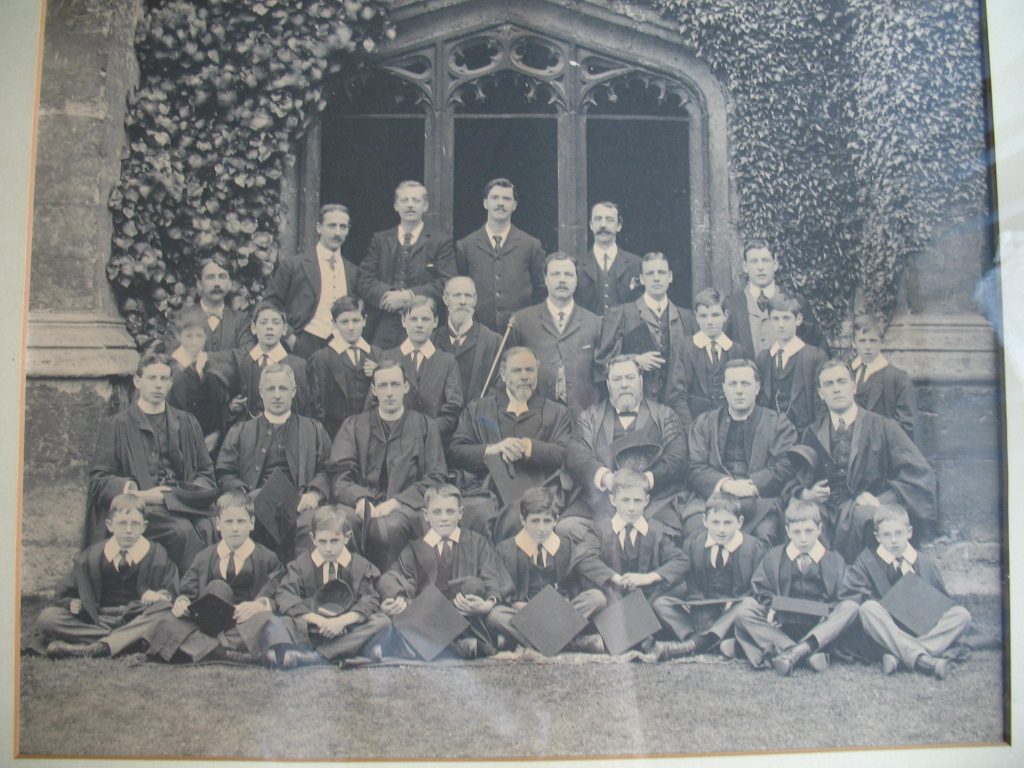
Parry-Jones is one of the five men in the second row down, on the extreme right and between two choirboys in the next row down (Photo courtesy of Magdalen College School).
In October 1909 he began to study medicine at Guy’s Hospital, London. Between 1909 and 1914 he took a number of courses, including: Anatomy, Dissections, Biology, Practical Physics, Histology, Medicine, Surgery, Insanity, Midwifery, Public Health, Pharmacology, Medical Jurisprudence, Clinical Medicine, Ophthalmic Surgery and Morbid Histology. During his training, he held the following appointments after taking his Second MB examination in June 1912: Surgical Clinical Clerk (June 1912–March 1913), Assistant Surgical Dresser (October–December 1912), Surgeon’s Dresser (April–June 1913), Post-Mortem Clerk (June 1913–March 1914), Ophthalmic Dresser (July, September and October 1913), Clerk to Anaesthetists (November 1913), Extern (March 1914), Obstetric Dresser (January–March 1914), Clinical Assistant (April–June 1914). He took his 3rd MB in January 1915. While at Guy’s, he was a forward in the Rugby XV which won the Hospital Cup four years out of five. He also played rugby for Kent and was a member of teams which went to France and Austria.
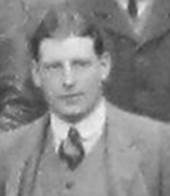
Owen Guy Parry-Jones, from a
Magdalen College Group Photograph 1909
(Courtesy Magdalen College, Oxford)
Military and war service
Parry-Jones served in the Oxford University Rifle Volunteer Corps and then the Oxford University Officers’ Training Corps, after which, on 29 May 1912, he was gazetted Second Lieutenant in the Special Reserve of Officers. He was called up on 6 August 1914 as Second Lieutenant in the 3rd (Reserve) Battalion, the Lancashire Fusiliers (Officers’ Training Corps) just before finishing his medical degree, and trained with them at Hull for five months. But because of the shortage of doctors, he was given a month’s leave in January 1915 to qualify and he became an MRCS and a LRCP in the same month. Consequently, he joined the Royal Army Medical Corps (RAMC) on 1 February 1915, was gazetted as a probationary Lieutenant on 15 February 1915, and confirmed in this rank a week later (London Gazette, no. 29,113, 26 March 1918, p. 2992). By 16 June 1915 he was a member of the 56th Field Ambulance, part of the 18th Division, and training at the RAMC Training Centre at Beachy Head, near Eastbourne.
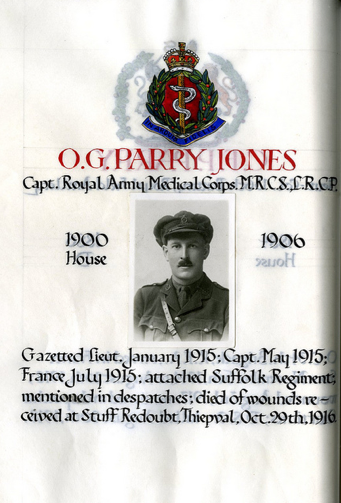
Owen Guy Parry-Jones, BA MB BCh MRCS LRCP
(courtesy of Sherborne School)
On 26 July 1915 the unit, comprising 18 mules, 35 horses, 6 general service waggons, 3 water carts, 3 ambulance waggons, and 258 personnel (including 10 doctors), embarked at Southampton, arriving in Le Havre on the following day. On 8 August Parry-Jones was promoted Captain, and on 13 August, when the 56th Field Ambulance was at St Gratien, he was sent to Querrieux to make arrangements for the treatment of the sick and wounded soldiers who were in that village. On 23 August the unit moved to Ville-sur-Ancre, just south of Albert, and on 19 September 1915 to Méricourt-sur-Somme, about ten miles further south.
From about 22 September 1915, Parry-Jones had been the Officer Commanding the Advanced Dressing Station in Albert itself (comprising one officer and 36 other ranks), where he was involved in the training of soldiers who wished to become medical orderlies. But on 14 November, when the 8th Battalion of the East Surrey Regiment was also near Ville-sur-Ancre, Parry-Jones was transferred out of the 56th Hospital and made its Medical Officer. The Battalion had landed at Boulogne on 28 July 1915 as part of 55th Brigade, 18th Division, and had spent most of the six months leading up to the Battle of the Somme within the triangle formed by Corbie, Albert and Méricourt-sur-Somme. So it was ready to be positioned opposite Fricourt and the German strong-point known as the “Tambour” when the battle started on 1 July 1916 with the destruction of the “Tambour” by a 2,000-pound mine.
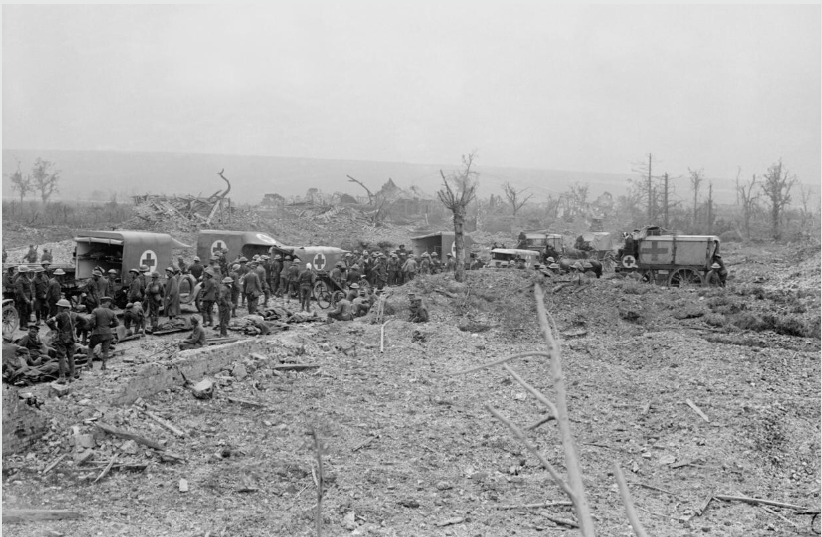
Battle of Bazentin Ridge; motor ambulances and horse-drawn ambulance wagons of the RAMC collecting wounded at Mametz (IWM Q 3975)
From 1 to 4 July, when the Battalion withdrew southwards to Bray, it was involved in the capture of Montauban, which cost it ten officers and 432 other ranks killed, wounded or missing, including Captain Wilfred Percy Nevill (1894–1916), the Officer Commanding ‘B’ Company, who had supplied each of his platoons with a football to dribble ahead of them across the 300 yards of no-man’s-land which they had to cross in the teeth of heavy machine-gun fire in order to reach the German trenches, and who was killed in action in the attack, aged 21. The survivors subsequently took part in the capture of Trônes Wood on 13–14 July.
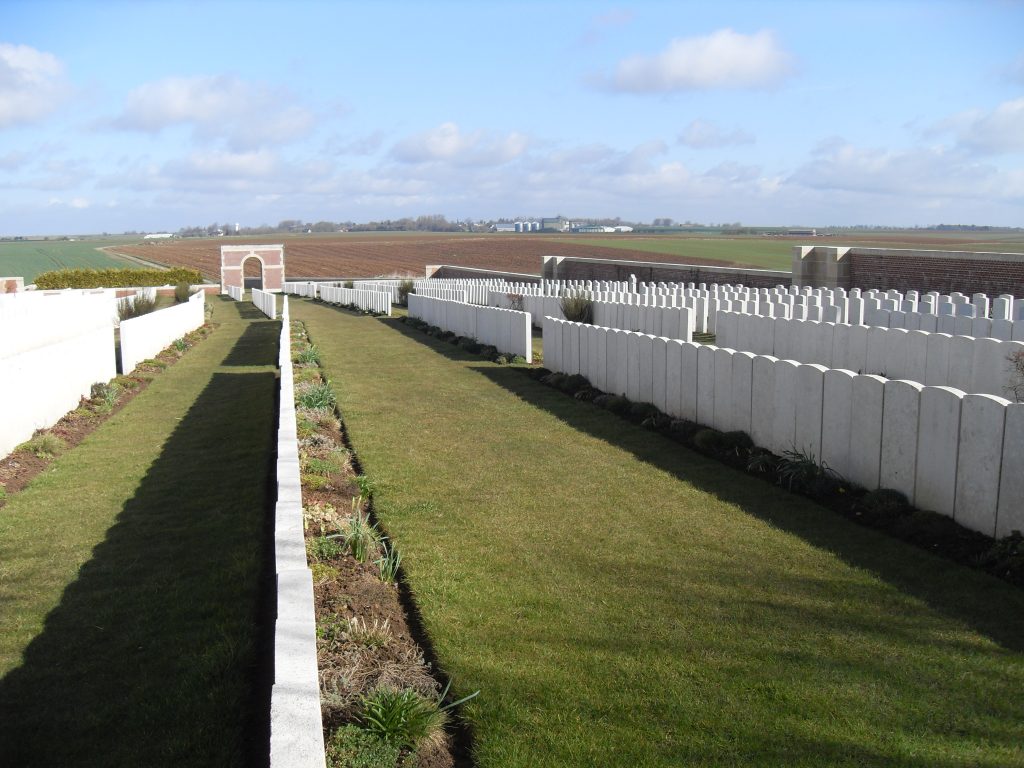
Puchevillers British Cemy was designed by Sir Edwin Lutyens (1869-1944) and holds 1,756 casualties. It was established in June 1916 in anticipation of the Battle of the Somme and served at first as the burial ground for No. 3 and No. 44 Casualty Clearing Stations.
On 14 July 1916, the remnants of the 8th Battalion moved back to Bray once more, where they spent a week before being pulled back north-eastwards by train to Erquinghem-Lys, just west of Armentières. It stayed here, re-equipping and training, until, on 22 August, it began to move southwards again, finally arriving at Puchevillers, south of Doullens, on 11 September 1916. The Battalion continued its training here until 23 September, when it moved eastwards to Blighty Valley (near Aveluy to the north-east of Albert) and South Bluff (28 September). Not far from here, on 29/30 September 1916, the 8th Battalion suffered heavy casualties before and during its assault on the east face of the Schwaben Redoubt, to the north of Thiepval, and was mentioned in dispatches (London Gazette, no. 30,101, 29 May 1917, p. 5,315). But on 28 September 1916, Parry-Jones was standing outside his Advanced Aid Post at Stuff Redoubt, near Aveluy, when he was struck by shell fragments. The same shell wounded 2nd Lieutenant Oliver Francis Madox Hueffer (1876–1931), the brother of the author Ford Madox Ford (1873–1939), who is best remembered for his novel The Good Soldier (1915). Parry-Jones was then moved back westwards to No. 3 Casualty Clearing Station, near Puchevillers, where he died on 29 September 1916, aged 29, probably a matter of days before the older P.A. Tillard joined the Battalion as a replacement officer. He is buried in Puchevillers British Cemetery, Grave III.B.11, with the inscription: “Oh true, brave heart. God bless thee whersoeer in God’s great universe thou art today”. He is commemorated in the Ante-Chapel, Sherborne School. He left £617 18s. 8d.

Puchevillers British Cemetery; Grave III.B.11.
Bibliography
For the books and archives referred to here in short form, refer to the Slow Dusk Bibliography and Archival Sources.
Printed sources
[Anon.], ‘Our London Correspondence; London, Thursday evening’ [the article refers to the Revd John Thomas Burt], Liverpool Mercury, no. 10,198 (17 September 1880), p. 5.
[Anon.], [Death announcement for the Revd John Thomas Burt], North Wales Chronicle (Bangor), no. 3,393 (24 September 1892), p. 8.
R[ichard] Caton Woodville [1856–1927], ‘The Surreys Play the Game’ [illustration of the incident with the footballs during the attack of 1 July 1916], The Illustrated London News, vol. 149, no. 4,032 (29 July 1916), p. 11.
[Anon.], ‘Captain Guy Parry-Jones, RAMC’ [obituary], The Times, no. 41,299 (16 October 1916), p. 10.
[Anon.], ‘Oxford’s Sacrifice: Short Notices: Magdalen College’ [obituary], The Oxford Magazine, 35 (Extra Number) (10 November 1916), p. 16.
Günther (1924), pp. 439–40.
[Anon.], [obituary of Maurice Parry-Jones], BMJ, no. 4,171, vol. 2 (14 December 1940), pp. 850–1.
A[lexander] R[oss] W[allace], ‘Percival Edward Holland Parry-Jones’ [obituary], The Shiburnian, vol. 40, no. 13 (March 1942), pp. 2–7.
J.A.S.L. Leighton-Boyce, Smiths the Bankers 1658–1958 (London: privately printed by the National Provincial Bank, 1958), pp. 1–2, 270–302.
McCarthy (1998), pp. 16–19, 45–6, 123–5.
Owen Slot, ‘Four balls that were kicked into legend’, The Times, no. 68,541 (10 November 2005), p. 91.
Archival sources:
OUA: UR 2/1/61.
WO95/2030.
WO95/2050.
WO339/19019.
On-line sources:
King’s College London, War Memorials, Guy’s Hospital, ‘Parry Jones, Owen Guy’: http://www.kingscollections.org/warmemorials/guys-hospital/memorials/parry-jones-owen-guy (accessed 18.11.2019).
